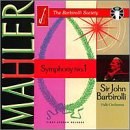| All Artists: Mahler, Halle Orchestra, Barbirolli Title: Symphony 1 Members Wishing: 0 Total Copies: 0 Label: Dutton Labs UK Release Date: 8/10/1999 Genre: Classical Styles: Forms & Genres, Suites, Historical Periods, Baroque (c.1600-1750), Modern, 20th, & 21st Century, Symphonies Number of Discs: 1 SwapaCD Credits: 1 UPC: 765387101527 |
Search - Mahler, Halle Orchestra, Barbirolli :: Symphony 1
CD Details |
CD ReviewsEXCELLENT MAHLER 1: DELIGHTFUL PURCELL Klingsor Tristan | Suffolk | 05/04/2006 (5 out of 5 stars) "What a fascinating performance of Mahler 1 this is. We seem to start off almost back in the world of Weber. There's a lovely summery sheen to the string harmonics. The horns in the introduction come straight from Freischutz, blending together magically. The cuckoos (singing in fourths rather than the more usual thirds) indulge in some judicious rubato. Then we set off on the exposition in the company of the Wayfaring Lad in relaxed and gemutlich mood. By the time we reach the recapitulation, however, with great whoops on the horns, Barbirolli has already made us well aware that this lied is now very much part of a symphony. That fahrenden Gesellen theme has by now been put through its symphonic paces in the development section and takes us on to a thrilling coda. The scherzo is even more of a surprise. The main material is taken at a much slower tempo than we're used to. This is quite definitely a landler, not a waltz (that comes later), and the slower speed makes of it a more stamping, peasant dance than usual, evoking thoughts of Breughel paintings. (This, by the way, is even more pronounced in Barbirolli's New York Phil performance originally available on their own collection of the complete Mahler symphonies). The slow movement's funeral march, of course, is also inspired by a painting - Caillot's high-Romantic depiction of a huntsman's cortege as he is taken to his burial by all the forest animals he has persecuted for so long. There is naturally therefore more than a whiff of irony about the marche funebre minor key Frere Jacques that is the theme of the main section. Barbirolli understands that the irony is written into the music and doesn't need any elaborate pointing from the conductor. He plays it straight and is all the more ironic for it. The sharply contrasting dance-band sections that follow ('mit parodie' instructs Mahler) are also played comparatively straight by Barbirolli - compared to, say, the slightly hysterical klezmer knees-up of a Bernstein - but he brings out the parody to the full in the Austrian town-band orchestration. As the finale develops we seem to have travelled farther with Barbirolli in this symphony that with most conductors. It all goes back to that relaxed, heat-haze opening and the reminder of that passage in this truly symphonic finale demonstrates just how long the symphonic journey has been. The big yearning second-subject on the violins, too, is real symphonic material and here is given all the characteristic Barbirolli passion (and groans). And the Halle brass bring the whole symphony to a suitably triumphant conclusion. This is a very fine performance of Mahler 1 in more than passable sound for its period. The fill-up is a Suite of Purcell tunes, arranged by Sir John. Very un-P.C. by today's 'Authentic Performance' standards, richly scored for a substantial body of strings, but a delight to listen to for all that. If Barbirolli lacks some of that magical lightness of touch that Beecham always brought to his arrangements of similar material, he replaces it with a seriousness of purpose and an understanding of the style worthy of the composer. " Very good indeed L. Johan Modée | Earth | 08/13/2004 (5 out of 5 stars) "As is the case with Rafael Kubelik's interpretation of Mahler's first symphony (DG or Audite), John Barbirolli's 1957 take is lively and personal while being faithful to Mahler's score (both to its spirit and its letter). The orchestra is not first-rate, but outshines the more famous ones by mere enthusiasm. This doesn't mean that the orchestra is bad. Woodwind playing, for example, is terrific and second-rate to none.
Barbirolli's interpretation highlights the extremes of the work - the lyrical theme in the first movement is beautifully grasped, and so is the Ländler-style in the second. The vulgar tone in third's Kletzmer-like middle section is almost equal to Kubelik's outstanding interpretation, and the storming energy in the finale takes off and culminates with a tremendous force. Recording quality is not the very best, but Dutton laboratories has given the stereo master tape a very good incarnation. Thus: Strongly recommended! " |

